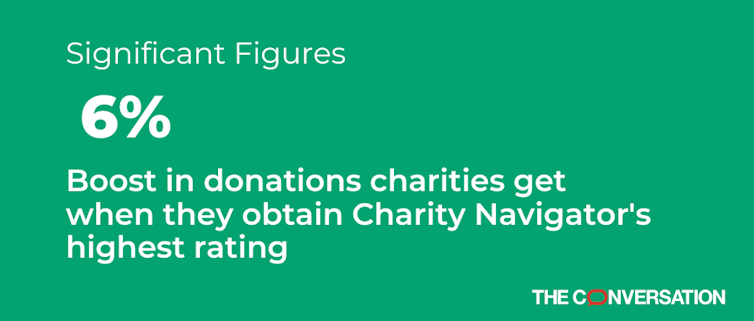

With multitudes of worthy charities to choose from – and the possibility that a poorly run or fake nonprofit might trick you into thinking it’s a good cause – it’s sometimes hard to know which ones to support.
That’s why many donors rely on ratings from groups like Charity Navigator, GuideStar and the BBB Wise Giving Alliance to make more-informed choices.
As a nonprofit researcher, I wanted to see if it was possible to measure the importance of these ratings to donors.
To find out, I conducted a study regarding the impact of Charity Navigator – the largest U.S. charity evaluator.
Donors reward boosted charities
I analyzed data drawn from Charity Navigator’s ratings for roughly 9,000 charities from 2002 to 2019.
Charity Navigator awards charities a rating between zero and four stars, with just under half of all organizations earning its highest rating.
I found that donors do reward charities for improving their rating, as long as they wind up with one of its two highest ratings.
Specifically, if a charity’s rating rises from two to three stars, or from three to four stars, its donations rise by about 6%. Larger charities – that is, those with net assets of more than US$5.6 million – benefit even more. Their donations grow 9% for an increase in rating from three to four stars, and 12% for an increase from two to three stars.
And yet, an increase in rating from one or two stars had no effect on donations, I found.
Many factors affect an organization’s rating. Spending more on delivering services and implementing policies to protect whistleblowers are examples of changes that can bump a rating up.
Getting an extra star or two typically gives charities a boost that’s larger than what many other researchers have found to be the impact of media campaigns and popular fundraising strategies – such as making thank-you calls and sending donors mugs, tote bags and other gifts.
How charities respond
I also wondered whether charities try to game the system by trying to do what they think the ratings groups want to boost their ratings.
To find out, I designed a model that simulated how charities would behave in a world without Charity Navigator.
I learned that, relative to that world, the existence of ratings appears to induce charities to change their behavior by just enough to earn themselves a higher rating.
That is consistent with other research that has found that charities often cut back on what they spend on such things as their administrative and fundraising operations to make donors feel better about supporting them.
Larger charities – those more reliant on donations to pay their bills, and those operating in sectors like housing and social services – are the most likely to alter their spending patterns to boost their ratings.
However, by reviewing the 990 form that charities must file with the Internal Revenue Service every year that details their expenditures, I’ve found that some charities are a little sneaky. Sometimes they classify – incorrectly – some of their administrative expenses as program-related expenses in what could be a bid to cut down on their overhead costs because they know it can improve their ratings.
This means that although rating charities encourages them to cut back on expenditures that donors might consider wasteful, and helps provide donors with valuable information, there’s a drawback. Earning a top-notch rating has become so important that some organizations may be trying to manipulate their financial data to achieve it.
During the years for which I was able to review the data, Charity Navigator still rated charities only according to their financial health, accountability and transparency. It has since added new categories, including information on impact, leadership and culture. The rating service added these because they thought they were factors that donors might care about.
While leadership and culture should be harder to game, I believe it’s possible that charities will see measuring impact as another opportunity to distort their activities toward things that are easier to measure or that will help improve their rating.
Jennifer Mayo does not work for, consult, own shares in or receive funding from any company or organisation that would benefit from this article, and has disclosed no relevant affiliations beyond their academic appointment.
This article was originally published on The Conversation. Read the original article.







